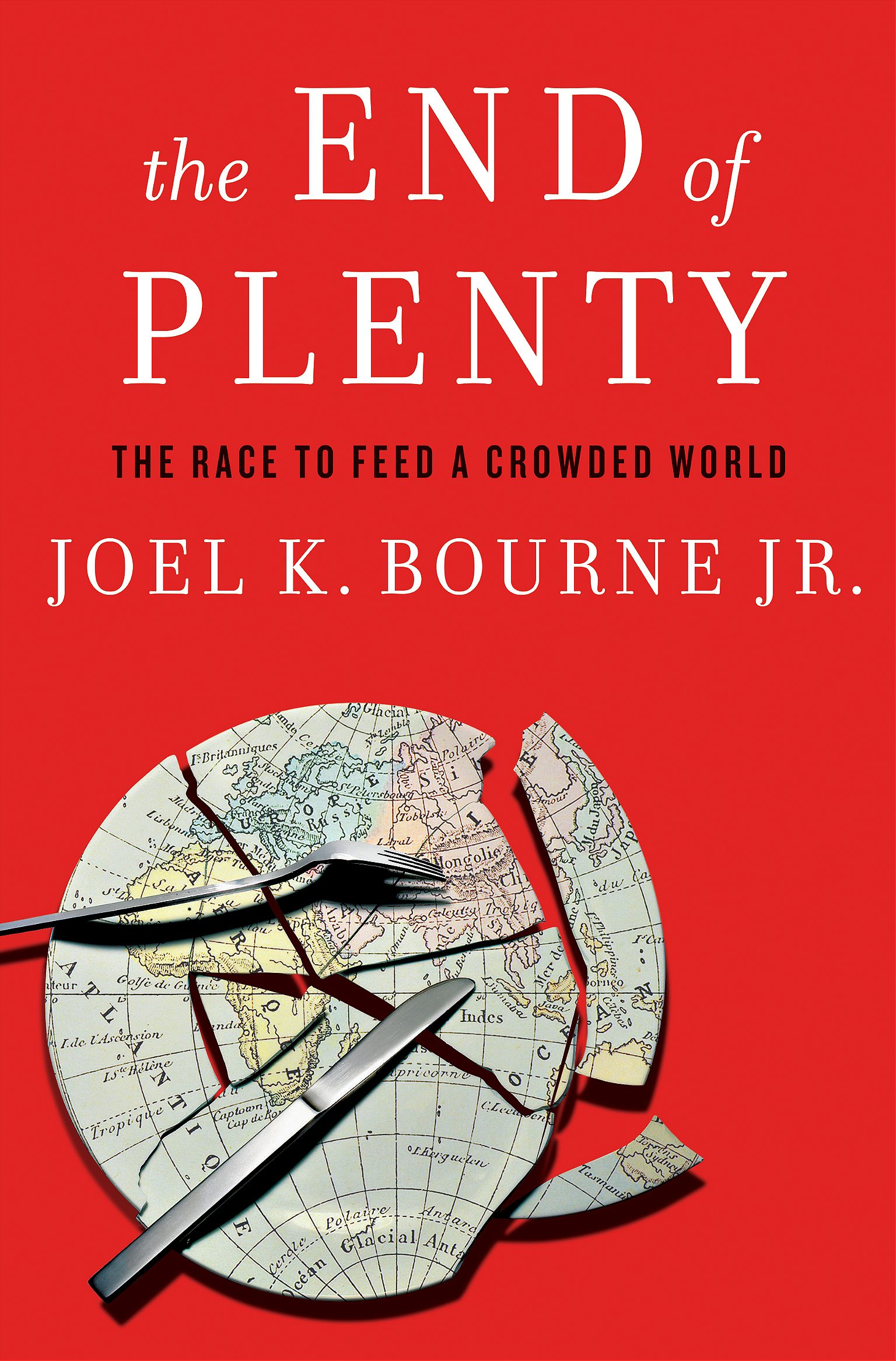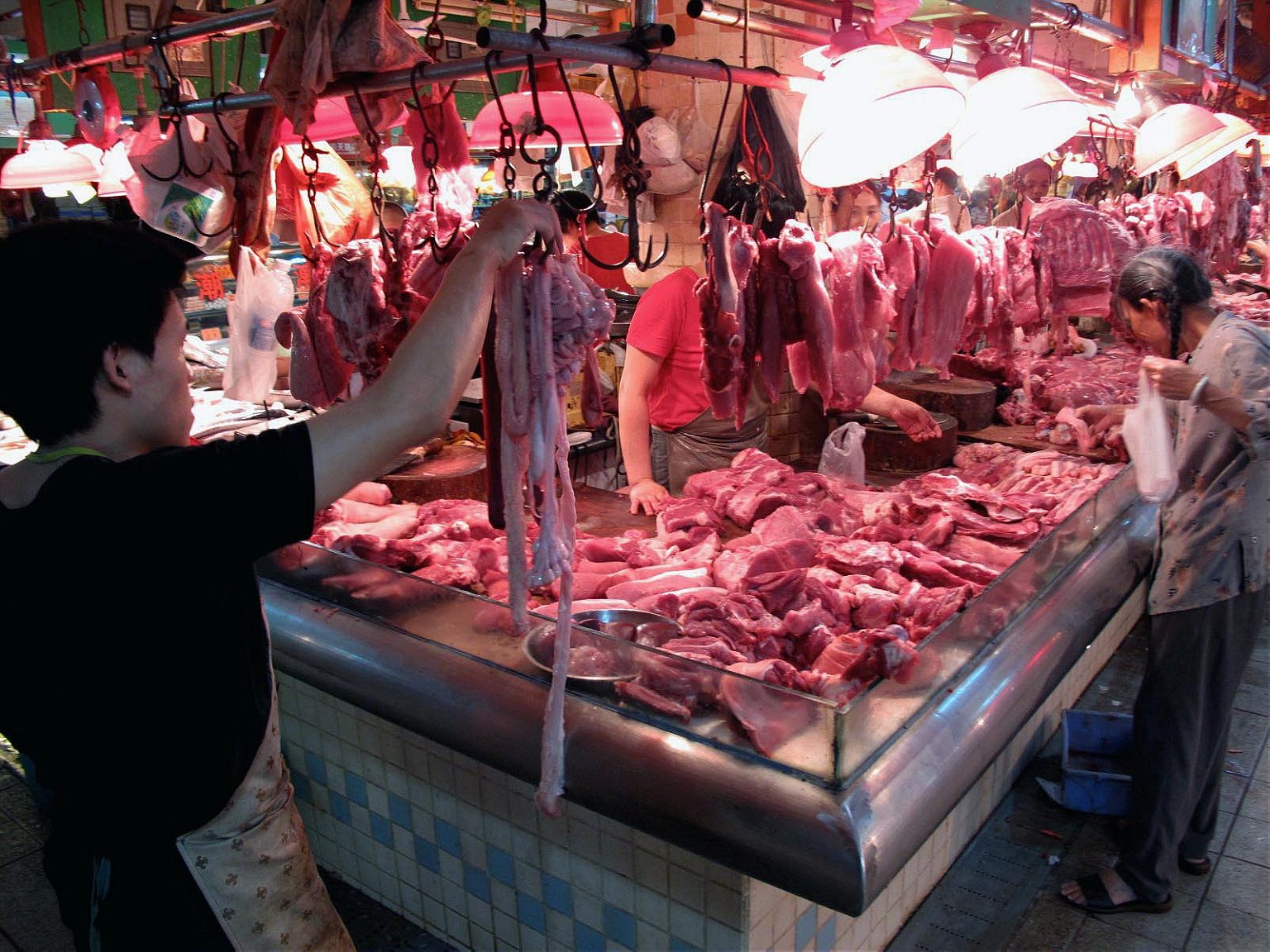In an excerpt from his book, The End of Plenty, Joel K. Bourne journeys to the heart of China’s growing pork addiction.
Excerpted from The End of Plenty: The Race to Feed a Crowded World by Joel K. Bourne Jr. Copyright © 2015 Joel K. Bourne Jr. With permission of the publisher, W. W. Norton & Company, Inc. All rights reserved.
When I make enough money I’m going back to my village in Henan and start a pig farm. A lot of people have done this. As long as you have 100 pigs or more you can make a good living. It’s a growing business.—Sun Haipeng, 26-year-old taxi driver, Guangzhou, 2008
In the midst of the food crisis I found myself sitting in a hot-pot restaurant in “Flower Village,” a strip mall in Guangzhou, China, growing hungrier with each passing plate. The megalopolis formerly known to the West as Canton is famous for cut flowers, my host informed me, and the restaurant he’d chosen, famous for entrails, specifically chicken cooked inside a pig’s stomach. Though I love Chinese food, an offal man I am not. So I politely picked my way through five or six greasy courses until a plate of small fried circles that looked exactly like calamari was passed around the table. Ah, finally something I could eat.
I popped one in my mouth and began to chew. And chew. And chew. The taste wasn’t bad, but it was a bit like gnawing on a rubber doughnut. I asked my host, an affable young importer of scientific testing equipment for the food industry named Stephen, what it was.
“That last part of pig intestine,” he said flatly. “How you say in English . . . asshole?”
The joke among Chinese who live in other parts of China is that the Cantonese will eat anything that flies except a plane, anything that crawls except a tank, and anything that swims except a boat—and every part of the pig save its hair. The reason given is that for thousands of years the small, crowded province on the southeast coast of China was desperately poor and hungry, a place of frequent famines where the emperor sent disgraced officials as punishment. Mountains rim the land, squeezing its crowded cities between steep slopes and the muddy shore. With limited arable land, the Cantonese pulled sustenance from the braided Pearl River delta and the South China Sea. When that wasn’t enough, they moved down the food chain to fat sandworms, big water roaches, and even a mushroom-like growth they found on rotted logs with the unappetizing name of black fungus.
Their diets and their fortunes changed dramatically after Deng Xiaoping designated the delta region as China’s first Special Economic Zone in 1980, reopening Canton’s legendary ports to Western trade. The province exploded with foreign investment. With a population of nearly 13 million, Guangzhou is now the third largest city in China, and migrant workers from China’s hinterlands have swelled the population of the greater metropolitan area to more than 40 million. Quaint two-story houses and storefronts have given way to an endless vista of office towers, apartment buildings, and factories belching smoke into the hot, humid South China sky.
For Chinese people, food is as important as the sky
But they haven’t forgotten their age-old priorities. As the tour guides say, in Beijing one talks, in Shanghai one shops, and in Guangzhou one eats.
“For Chinese people, food is as important as the sky,” says Stephen, who was born in the city and returned after graduating from university in Beijing. “This is especially true in Canton. We eat five meals a day—breakfast, lunch, dinner, afternoon tea, and late-night meal. And we eat anything. Snake, dog, cat, civet cat, silkworm, cricket, scorpion, rat.”
“Is rat good?” I asked.
“It’s better than frog.”
But it’s pig, not frog or rat, that is the most beloved food in all of China, accounting for nearly 65 percent of all meat consumed. The Chinese were among the first to domesticate the wild boar, some 10,000 years ago. For most of China’s history, nearly every rural family kept a pig under the house as sort of a living garbage disposal for food scraps and waste—a symbol so powerful that the Mandarin character for “home” actually depicts a pig under a roof. Legend also holds that the Chinese were the first to cook the savory meat over fire: A Chinese peasant returned home one day to find his bamboo house burned down and his pig—his family’s only source of boiled meat—smoldering in the ashes. When the distraught man grabbed a leg to remove the animal, he discovered the tantalizing aroma of roast pork and changed Chinese cuisine forever.
In Chinese astrology, those born in the year of the pig are considered lucky, because it is said that they will always have plenty to eat.

Not surprisingly, the price of pork in the marketplace is a key indicator of Chinese zeitgeist, much like the price of gasoline in the United States. When pork is cheap, the hundreds of millions of Chinese workers who spend 40–60 percent of their income on food are relatively happy. When pork prices rise, the collective growl of a billion stomachs can rattle Beijing. Many people remember the young man with shopping bags standing down a column of tanks in Tiananmen Square in 1989. Few outside China, however, remember that the protests—which swept across many major cities and unleashed the fiercest political unrest in recent Chinese history—were preceded by a year of high food inflation and pork rationing in much of the country. The government now keeps 200,000 tons of frozen pork in a strategic reserve to help ease supplies when prices rise, just as the United States has a strategic petroleum reserve.
After Tiananmen Square, China’s government encouraged pork production—through subsidies, tax breaks, and even direct payments to farmers—to stabilize pork prices and availability. In 1980 China was home to 200 million hogs. In 2005 that number had more than tripled, to 650 million.
The People’s Republic consumes half of the world’s pork each year
Thanks to rising incomes in China’s burgeoning new middle class, per capita pork consumption has doubled since 1990, from about 20 kilograms a year to more than 40 in 2014. Chinese city dwellers eat twice as much pork as their rural cousins, and in the booming metropolises, consumption of chicken, beef, and seafood has risen dramatically as well. Though the average Chinese citizen still eats less than half the meat of someone in England or the United States, the People’s Republic consumes half of the world’s pork each year.
You can get a sense of China’s growing pork addiction in the bustling Construction New Village Market—a dark, almost subterranean cavern jammed with stalls beneath a mountain of concrete apartment towers in Guangzhou. The orderly rows of vegetables, fish, and sacks of rice swirl with shoppers, mostly women, picking up something for dinner on their way home from work. In one row, stall after stall features glistening red meat and every cut of pork imaginable, including intestines, snouts, and ears. Butchers whack away with cleavers, carving out ribs, shoulders, and tenderloins, as blood—which you can buy by the cupful—covers the floor.
Times are good, said He Xingdong, a smiling 35-year-old butcher who had sold fresh pork in Guangzhou for a decade. “Now average people eat pork, and the rich eat seafood,” he laughed. “Ten years ago I used a motorcycle to bring in my pork. Now I use a truck.”

In the next stall over, 67-year-old Mrs. Quian haggled with a butcher over a choice cut. They finally agreed on a price, and while the butcher wrapped her purchase, she told me she cooks for her family of four and prepares a meat dish at every meal. She claimed she was actually trying to cut down on pork, though the slab of shoulder in her shopping bag belied the fact. “The first five years here we spent a lot of money on pork,” she admitted. “But last five years we spend less, because we are worried about our health.”
Though most of China still buys the freshest pork from a traditional wet market like this one, a growing number of urbanites are following their Western counterparts and buying precooked or prepackaged meals to pop in the oven or microwave at home. Even in the more traditional Construction New Village Market, a young woman manning the “Day and Day Hand-Pulled Pork” stall near the entrance was doing a brisk business in takeout, selling slow-roasted, barbecued delicacies. The mouthwatering smell wafting out of the stall took me back to the pig pickings of my North Carolina youth. “Six years ago we started with one stall,” she said. “Now we have 15 all over Guangzhou.”
The End of Plenty comes out in paperback in June 2016.
Cover image: Jeremy Keith